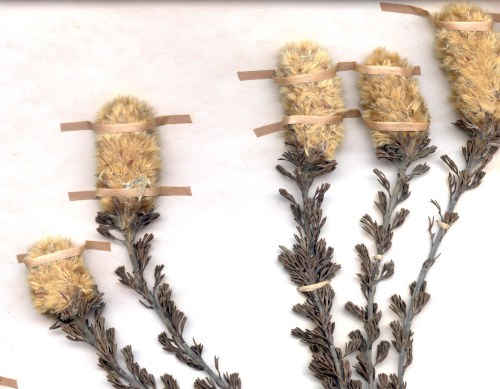
Home
Mission
Overview of Project
Project Staff
Sponsors
Achievements
Checking, Illustrations
Upcoming Activities
Id and Species Lists
Protea Information
Protea Gallery
Growing Proteas
Interim Dist. Maps
Publications
Afrikaanse Inligting
![]()
The one that got away?
 A
specimen came to light during our evaluation of herbarium data – we need these data
to work out Red Data Book status and to assess our contribution in terms of new data
– that poses a bit of a problem.
A
specimen came to light during our evaluation of herbarium data – we need these data
to work out Red Data Book status and to assess our contribution in terms of new data
– that poses a bit of a problem.
It is a Paranomus, clearly similar to Pa capitatus, Fineleaf Scepter, but yet quite different. In GISS the herbarium specimen looks quite unlike Pa capi – the leaves are very small, closely clasp the stem and the flowerheads are much larger than is normal for Pa capi. It appears that the stems are long and thin. We have not yet atlassed any such species.
Of course – it has to be – the specimen was collected by Thomas Stokoe. There are three herbarium sheets, almost certainly from the same plants. One of the sheets is labelled "Worcester Division Boschjesveld mountains, Worcester side", and was collected on 01 October 1955. The other sheet is dated October 1933 and gives the collection locality as "Somerset West Sneeukop", and the third states: "Stokoe collected Somerset West October 1955." The first specimen has a South African Museum Herbarium label, but the latter two have National Herbarium Pretoria labels, suggesting that they are duplicates.
The new Paranomus scanned from a herbarium sheet

Interestingly, the specimens have finished flowering. This implies that these plants probably flowered in August and September, which is early in the season for Pa capi, which flowers in October-November. Little else can be gleaned from the herbarium specimens, because height, habit and colour are not noted on the labels. The appearance though, is of a robust plant with long thin stems, all upright. However, it cannot be determined if plants are sparsely branched or comprise dense bushes with long stems.
In discussing the specimens with Dr John Rourke, it is not possible to reach a conclusion without more information. What is the locality? Does it flower in spring? What is the habit of the plants? Could these be rampant growth and large heads in young plants of Pa capi during a good, wet cycle? Or might it be a new species? The heads are very bushy with dense hairs on the petals. Far more so than is typical of Pa capi. But are they different enough for recognition as a distinct type?
John showed me another specimen in the Compton herbarium that closely resembles Stokoe’s specimens. It was collected by Chris Burgers in August 1977 on the north slopes of Omklaarsberg S of Trappieskraal Jonasplaats. He notes that the plants are sparsely branched, 0.7m tall and open from the top downwards (acropetally). Again the specimen is finished flowering.
Unfortunately the area burned in December last year - we were within 3 km of the area at the AGT up Jonaskop. And we are in a dry cycle. So we might have to wait a few years for resolution on this one.
Tony Rebelo
Back PAN 53